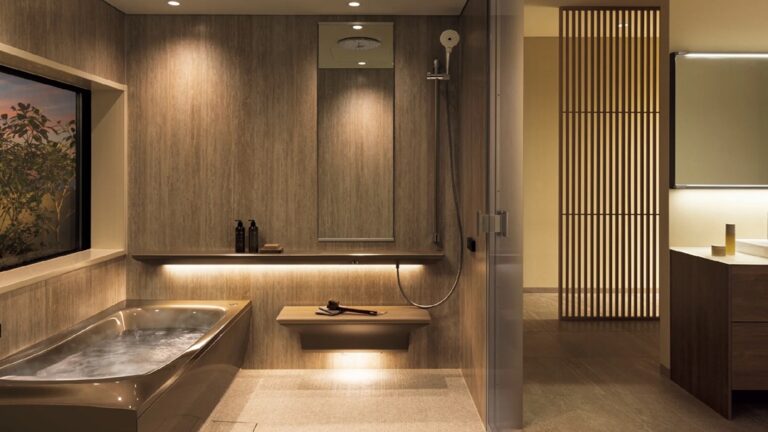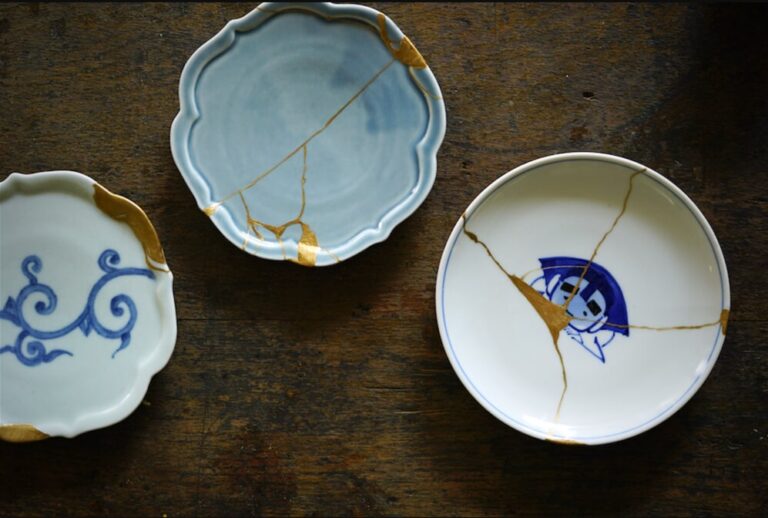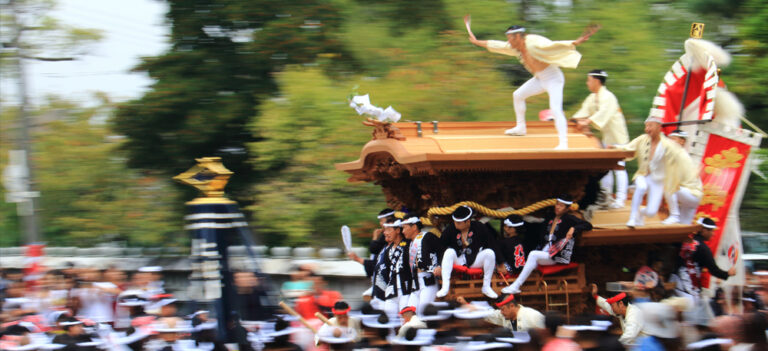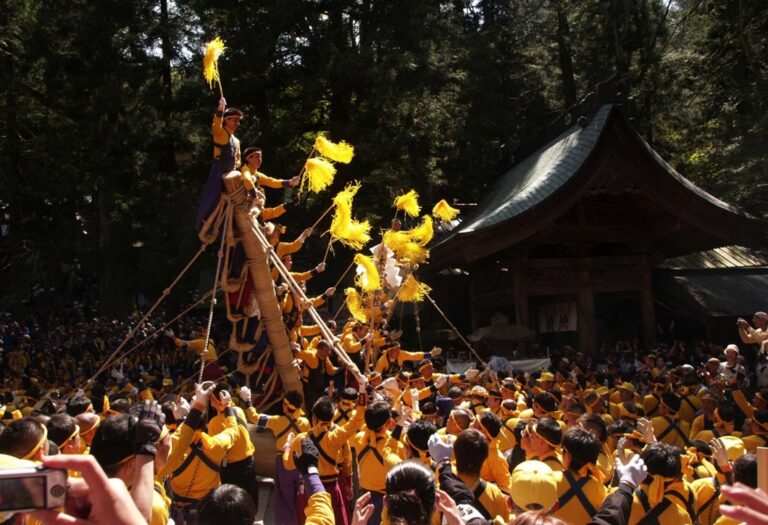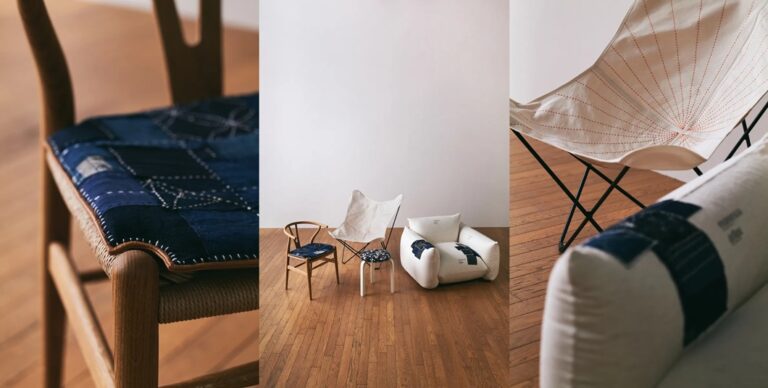What Do Kyoto’s Maiko Actually Do?
The kimonos of maiko stand out vividly against the streets of Kyoto.
However, behind their glamorous appearance lies a job supported by years of training and strict discipline.
They are not simply subjects for tourist photos; they support Kyoto’s nightlife through their hospitality skills.
Do you know what maiko do?
Why not take a quiet peek into this dazzling yet profound world?
What Kind of Work Does a Maiko Do?
A maiko is an apprentice in training to become a geiko (Kyoto dialect for geisha).
Though still a trainee, she already takes part in real banquets (ozashiki) and interacts with guests.
By day she studies dance, shamisen, singing, tea ceremony, and flower arrangement.
By night, she performs these arts and entertains customers at the teahouses.
In other words, she is learning while practicing hospitality in the real world.
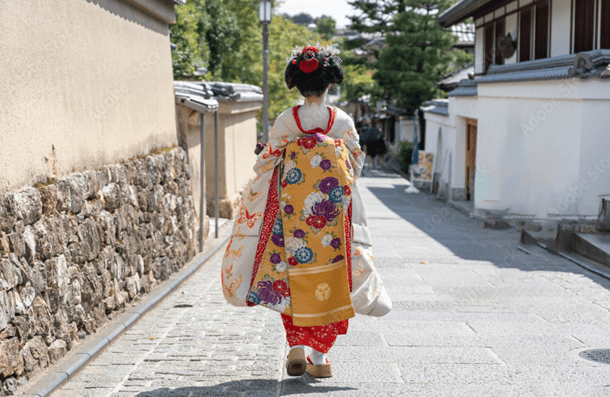
Maiko share the same stage as geiko, yet remain apprentices, refining their manners, language, and gestures under close guidance.
It takes years of both study and work to master etiquette and performance before becoming a full geiko.
The History of Maiko — Tradition Living in Kyoto’s Five Hanamachi
The culture of maiko began in Kyoto’s Gion district, near Yasaka Shrine, during the Edo period.
At first, teahouse girls served tea and sweets to pilgrims, but soon began entertaining guests with dance and song.
Thus, the hanamachi (literally “geisha district”) were born.
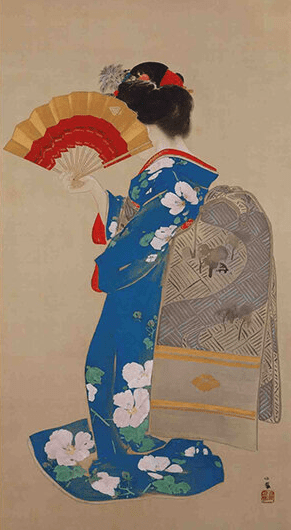
In the Meiji era, maiko and geiko became officially recognized occupations under Kyoto’s licensing system.
Today, five hanamachi remain: Gion Kobu, Miyagawa-cho, Ponto-cho, Kamishichiken, and Gion Higashi, each with its own history and style of dance.
Gion Kobu
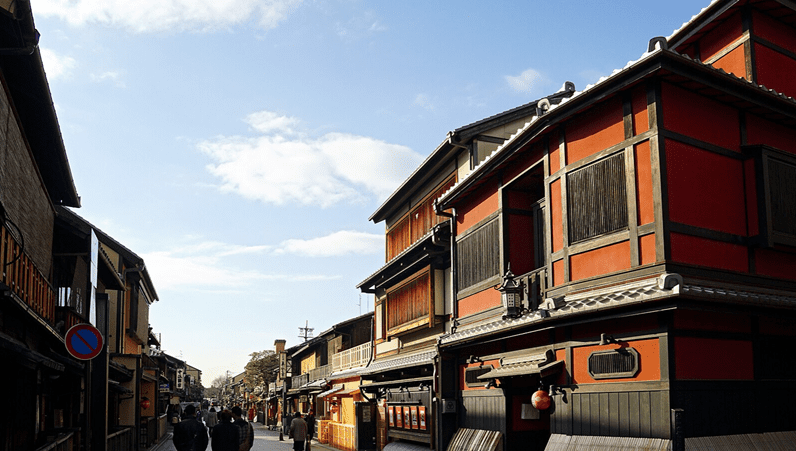
The largest and most prestigious hanamachi.
Located before Yasaka Shrine, its stone-paved alleys and lattice teahouses define the image of Kyoto itself.
The maiko here study the Inoue-ryū school of Kyomai (Kyoto-style classical dance),
characterized by restrained movements and an expression of emotion through elegance and stillness.
The annual “Miyako Odori” in spring is its most famous performance.
Miyagawa-cho
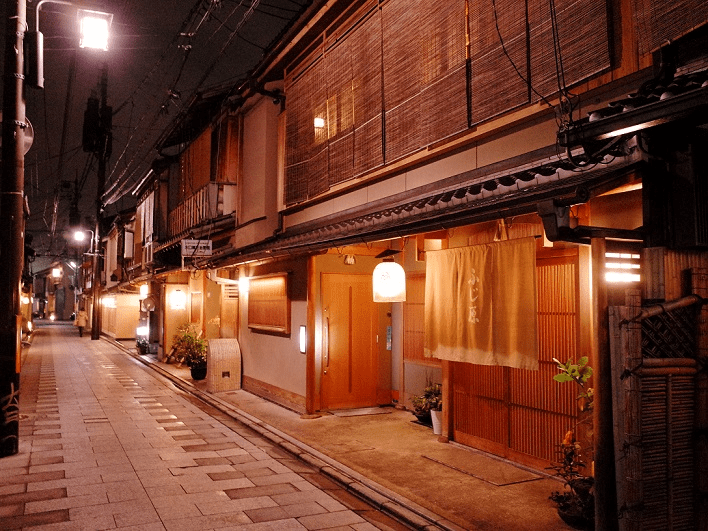
Situated along the east bank of the Kamo River, this calm district retains the atmosphere of old playhouses.
Maiko mainly study Wakayagi-style dance, characterized by delicate and fluid motion.
It hosts the “Kyo Odori” in spring and the “Mizue-kai” in autumn.
Ponto-cho
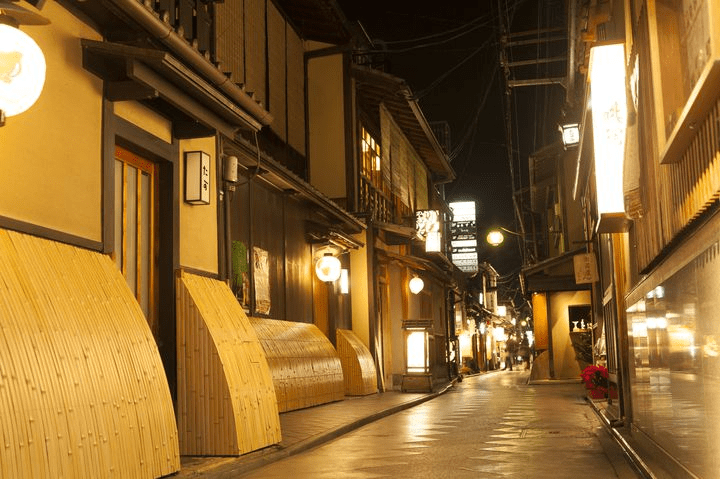
A narrow street beside the Kamo River, lined with teahouses and restaurants whose lanterns glow at dusk.
Here maiko learn Onoe-style dance, expressive and rhythmic.
The “Kamogawa Odori” is Ponto-cho’s signature event.
Kamishichiken
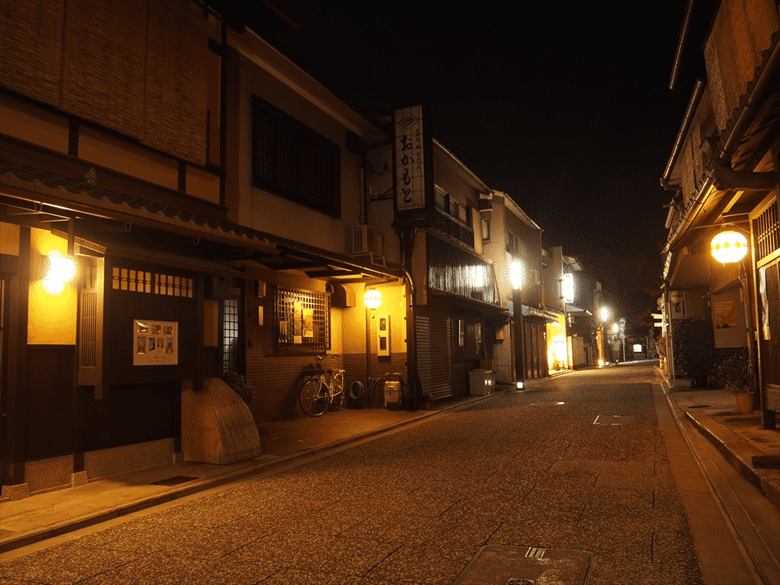
Near Kitano Tenmangu Shrine, this is Kyoto’s oldest hanamachi.
It began in the 15th century when seven teahouses were built from leftover temple lumber,
and was later granted official status by Toyotomi Hideyoshi.
Maiko perform Hanayagi-style dance, emphasizing classical and dignified form.
The “Kitano Odori” in spring preserves its traditional grace.
Gion Higashi
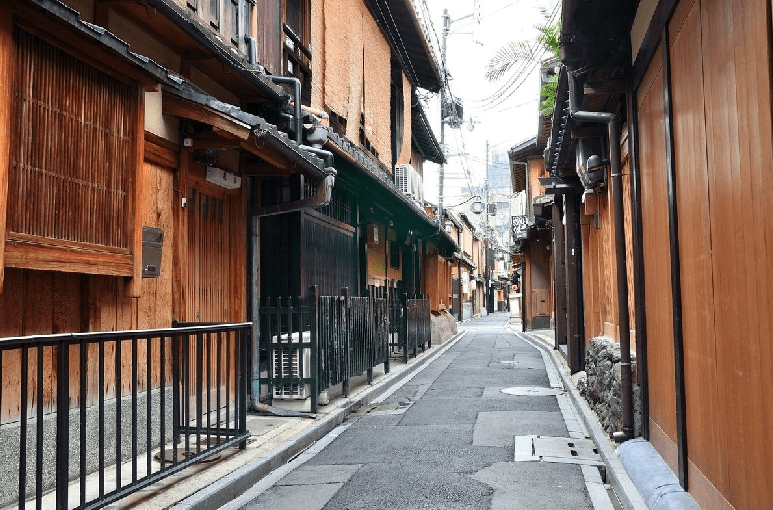
Next to Gion Kobu, this small hanamachi balances modern buildings and traditional teahouses.
Its maiko study Fujima-style dance, expressive and emotional.
The summer “Yukata-kai” and autumn “Gion Odori” are well-known events.
Though each district has its own personality, all share the same spirit — preserving Kyoto’s refined culture through art and courtesy.
Note: “Hanamachi” literally means “geisha district.” In Kyoto, it is traditionally pronounced kagai.
A Maiko’s Day — Repetition of Training and Grace
A maiko’s day is far more structured than her glamorous nights.
6:30 a.m. — Wake up. Help the okāsan (proprietress) of the okiya with chores and cleaning.
⇩⇩⇩
8:30 a.m. — Begin lessons at Yasaka Nyokoba Gakuen: dance, singing, shamisen, tea ceremony, flower arrangement, and more.
⇩⇩⇩
12:30 p.m. — Lunch and rest; sometimes review lessons or take a nap.
⇩⇩⇩
3:30 p.m. — Apply oshiroi makeup, style hair, and dress in kimono.
⇩⇩⇩
6:00 p.m. — Attend ozashiki; perform dances and spend time with guests.
⇩⇩⇩
10:00 p.m. – late night — Return home after banquets, prepare for the next day, and sleep.
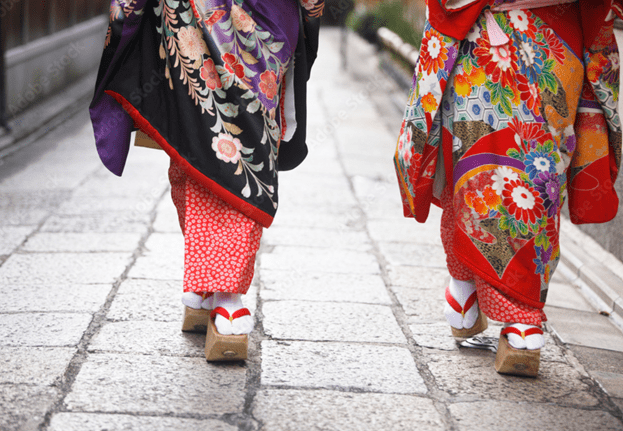
Training and work continue every day, with only a few days off per month. Tardiness or absence is strictly forbidden—self-discipline is essential.
Maiko as “Walking Works of Art” — Kimono and Adornment
A maiko’s appearance is a living artwork, combining Kyoto’s traditional crafts.
Her vibrant kimono, a five-meter darari obi trailing from her back,
and her seasonal hana kanzashi (flower hair ornaments)—
all are supported by the work of expert artisans.
Kimono (Susohiki) — A maiko’s kimono is a special long-hemmed type called susohiki, longer than a normal furisode. She lifts the hem when walking outside, and lets it trail gracefully indoors. Patterns and fabrics change with the seasons—cherry blossoms or plum in spring, flowing water or morning glories in summer, maples in autumn, and camellias in winter— reflecting the natural transitions of Kyoto throughout the year.
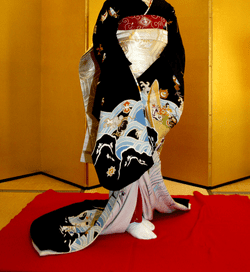
Darari Obi (Trailing Belt) — The darari obi is a long and heavy obi that can measure 5-7 meters in length and weigh 6-7 kilograms, and has the okiya’s crest at the end. As it cannot be tied by oneself, it must be done by a male dresser called an otoko-koshi. A fastener called a “pocchiri” is attached to the front to add a touch of elegance.
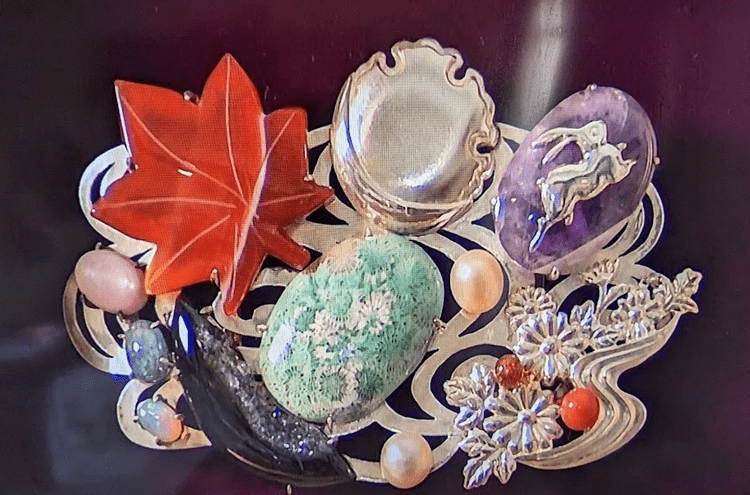
Makeup and Hair — Her entire face is covered with white oshiroi powder, leaving a W-shaped space at the nape.
Young maiko paint only the lower lip red.
Her real hair is styled into traditional nihongami shapes such as waresinobu or ofuku, depending on experience.
Seasonal hana kanzashi adorn her hair—
cherry blossoms in spring, fans and morning glories in summer,
chrysanthemums and maples in autumn, camellias and narcissus in winter.
Footwear (Okobo) — Okobo are tall wooden clogs, different from geta or zōri. Their clacking sound as a maiko walks has become a signature of Kyoto’s alleys. They retain the natural color of wood, a simple contrast to her colorful attire.
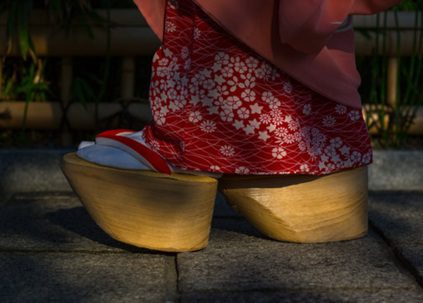
The kimono, obi, and hair ornaments are usually owned by the okiya and lent to each maiko.
An average full outfit costs as follows:
Kimono (susohiki): ¥800,000–3,000,000
Obi (darari): ¥500,000–1,500,000
Pocchiri clasp: ¥100,000–1,000,000 (varies by craft or jewels)
Hana kanzashi (one day’s set): ¥50,000–300,000 (higher for holidays)
Accessories and undergarments: ¥30,000–80,000
Okobo (wooden footwear): ¥30,000–50,000
Hairdressing and makeup (per day):: ¥10,000–30,000
Thus, the attire worn by a maiko walking through Kyoto may total around ¥2.8 million on average,
or ¥6 million for high-level or ceremonial occasions.
When antique fabrics or lost-weave techniques are included,
its value can become “marketless”—sometimes worth tens of millions of yen.
It is truly a world where “price cannot be set.”
Column: The Cost of a Stain
If a kimono is stained, stain removal alone can cost ¥30,000–100,000.
If tailoring repairs are required, ¥300,000–1,000,000 or more may be needed.
Damaging the obi or embroidery can mean irreparable = full compensation (hundreds of thousands to several million yen).
Taxi drivers in Kyoto who understand these circumstances never try to overtake when a geimaiko is nearby,
and sometimes they even stop their cars.
If they were to soil or collide with her by accident, even if the maiko herself were not injured,
the compensation demanded by her okiya for the damaged clothing and accessories would be enormous.
The Formal Way to Enjoy Time with a Maiko — Opening an Ozashiki
To enjoy time properly with a maiko, it begins by arranging a seat at an ochaya (teahouse).
The ochaya prepares the food and drinks, contacts the okiya, and arranges the maiko, geiko, and jikata (musicians who play shamisen and sing).
Customers cannot directly request maiko from the okiya.
The ochaya is responsible for all arrangements and settles the total payment together — this is the Kyoto custom.
The total cost billed by the ochaya for one banquet includes the following:
Seat fee (payment to the ochaya)
Venue charge + mediation fee. Around ¥20,000–30,000 per person.
Note: Ochaya do not serve food themselves; meals are ordered from partner ryōtei (traditional restaurants).
Food and drink (from ryōtei or catering)
Around ¥20,000–30,000 per person (over ¥50,000 at high-end establishments).
Charged per guest, multiplied by the number of people.
Hanadai (performance fee for geimaiko)
Maiko: about ¥30,000 per hour.
Geiko: about ¥50,000 per hour.
Usually 2–3 are invited, for about two hours.
Service fee / gratuities (tips)
Envelope gifts for maiko, geiko, jikata (musicians), nakai (attendants), and the okami (proprietress).
Around ¥10,000–20,000 per person.
For two or three guests enjoying a genuine ozashiki, the realistic total is around ¥400,000–¥600,000.
Depending on the number of people and the grade of cuisine, the cost may exceed ¥1,000,000.
However, this is a world of ichigen-san okotowari — “no first-time customers.”
Without an introduction, one cannot even sit at the table.
Column: The Price of a Tip
When a maiko is invited to ozashiki repeatedly, the relationship between her and the guest is called hiiki (patronage).
Among these patrons, those who continue their support for a long time are called danna-san (patrons), and they sometimes provide funds for clothing or daily expenses.
There is even an anecdote told by a former maiko on an internet forum — that a favored patron once gifted her ¥10,000,000, saying “Use this to help cover your clothing expenses for the year.”
Although the truth of the story is uncertain, it shows how exclusive and extraordinary the world of maiko entertainment is.
Maiko entertainment has always been an “elegant luxury” reserved for the chosen few —
even a single tip exists on a different scale.
Ozashiki Games — Between Art and Play
After the dances and songs at the banquet, the ozashiki asobi (teahouse games) begin.
These are traditional games that maiko and guests enjoy together.
Konpira Funefune — Players clap to the rhythm, competing on whether to grab or leave the bowl in the center.
Toratora — A gesture-based rock-paper-scissors game played on either side of a folding screen. The winner receives cheers.
Kiku no Hana (Chrysanthemum Flower) — A small flower is hidden under one of several cups; the one who finds it drinks as a playful forfeit.
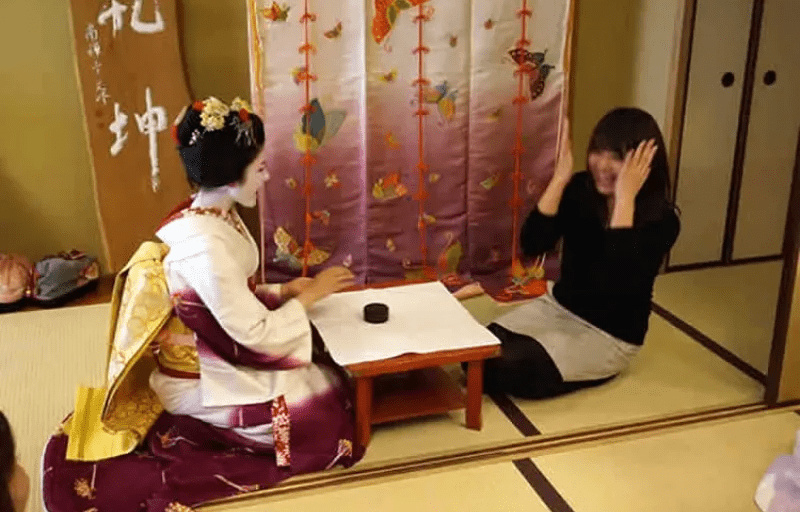
Bekuhai — A spinning top decides which funny-shaped cup a player must drink from — a game of luck and laughter.
Tōsenkyō — Players throw fans toward a target; points are scored based on how the fan and target fall.
More important than winning or losing is enjoying the atmosphere.
Delicious food, good sake, and Kyoto beauties — when laughter and rhythm blend, the ozashiki reaches its liveliest moment.
Experience Maiko Culture for Yourself
How about it? Has your curiosity been piqued? For those thinking, “I’d like to try it a little,” Kyoto offers programs for visitors.
Entering a real ozashiki requires an introduction, but to preserve the culture, Kyoto has established various experience-based programs.
Women can try a henshin taiken (transformation experience) to dress as a maiko, and men can enjoy the guest experience that lets them take part as customers.
Both allow anyone to experience Kyoto’s traditions casually.
Note: In Japan, wearing kimono is considered an act of respect and admiration, not cultural appropriation. If you’re unsure, please feel free to try it!
List of Experience Facilities
GION MAIKOYA
Contents: Maiko dance performance, simple ozashiki games, English interpreter available.
Price: Dinner show from around ¥24,000 per person.
English support: Yes.
Gion Corner
Contents: One-hour show featuring seven Kyoto arts — Kyomai dance, tea ceremony, gagaku, and more.
Price: See official website (seasonal operation).
English support: Yes.
Private Ozashiki Experience (private plan)
Contents: Small-group plan with dance performance, light ozashiki games, and dining.
Price: From around ¥210,000 for up to ten people.
English support: Varies by provider.
Rules and Penalties in Kyoto
Maiko are bearers of Kyoto’s traditional performing arts and are regarded as cultural treasures.
Therefore, unauthorized photography or physical contact may be punishable by law.
| Act | Main Law | Penalty Example |
|---|---|---|
| Following, touching, or blocking the way | Kyoto Prefecture Anti-Nuisance Ordinance | Up to 6 months’ imprisonment or fine up to ¥500,000 |
| Unauthorized photography, stepping into the road to pursue | Minor Offense Act / Road Traffic Act | Fine up to ¥50,000 |
| Entering private or shrine grounds marked as off-limits | Penal Code Article 130 | Up to 3 years’ imprisonment or fine up to ¥100,000 |
| Damaging cultural property or buildings | Penal Code Articles 260–261 | Up to 5 years’ imprisonment or fine up to ¥300,000 |
| Littering or defacement | Kyoto City Beautification Ordinance | Fine up to ¥30,000 |
The narrow alleys and private streets of the hanamachi are not tourist walkways but living spaces.
Violations are reported to the police, and there have been actual arrests and fines.
When visiting Kyoto’s hanamachi, remember — those who watch are also part of what sustains this culture.
Pride in a Glittering World

The world of maiko is both glamorous and demanding, supported by strict customs and relentless effort.
They wear exquisite costumes, refine their manners and arts, and illuminate Kyoto’s nights.
This tradition endures because there are those who watch, those who experience, and those who support it.
If you see a maiko, please observe quietly and respectfully from a distance.
If you feel inspired, visit one of the experience facilities to touch this living culture yourself.
A maiko is not a relic of the past — she embodies Kyoto’s spirit of hospitality that continues to this day.
You might also be interested in these articles
■How Edo Boys Got Drip?

Editor and writer from Japan. Not the best at English, but I share real stories with heart and honesty — aiming to connect cultures and ideas that matter.




